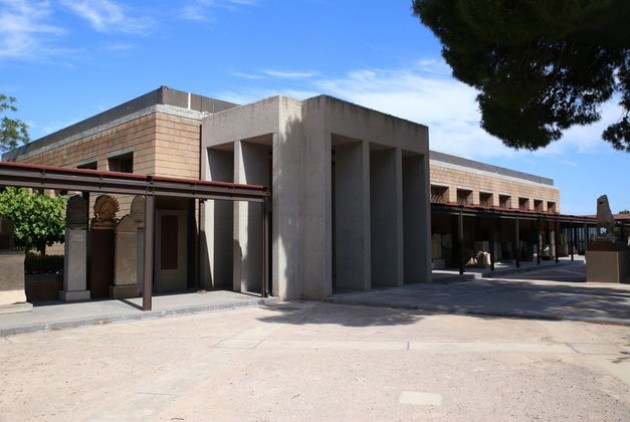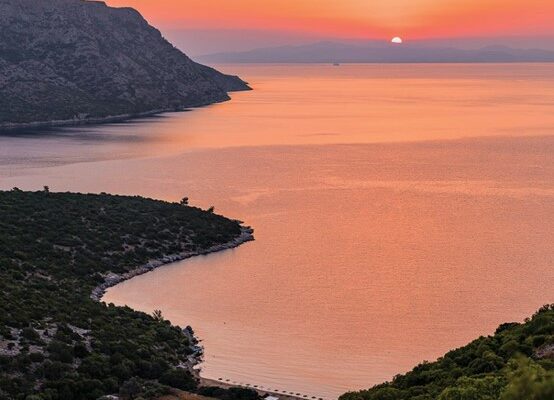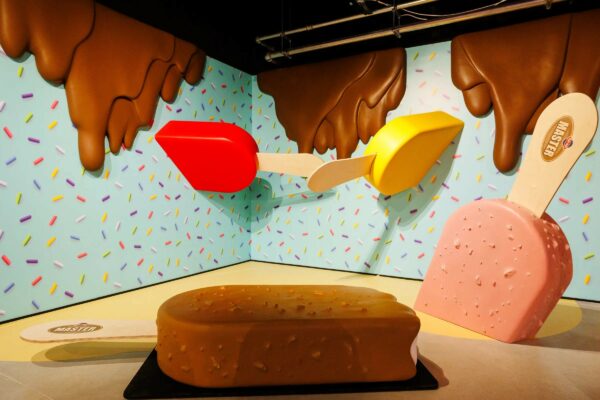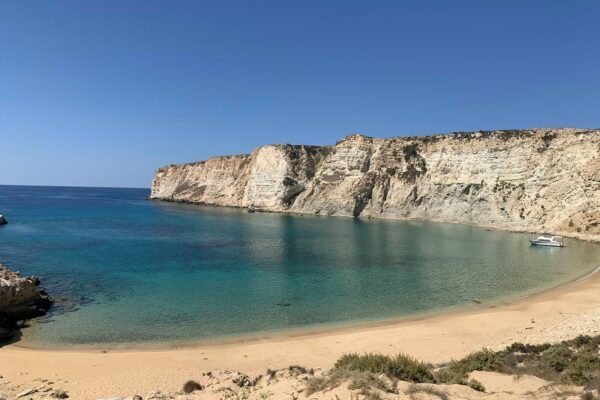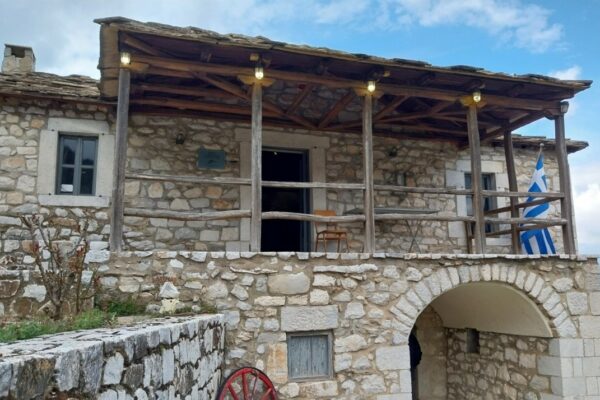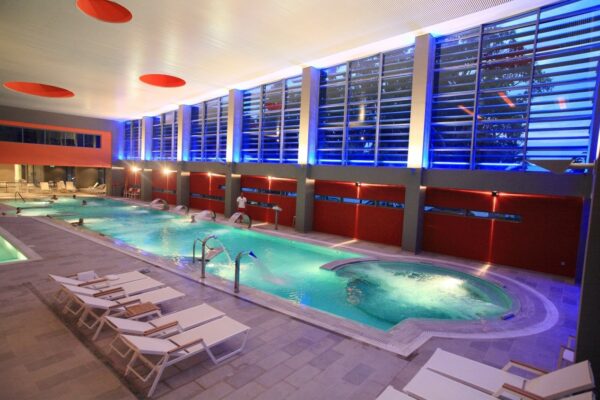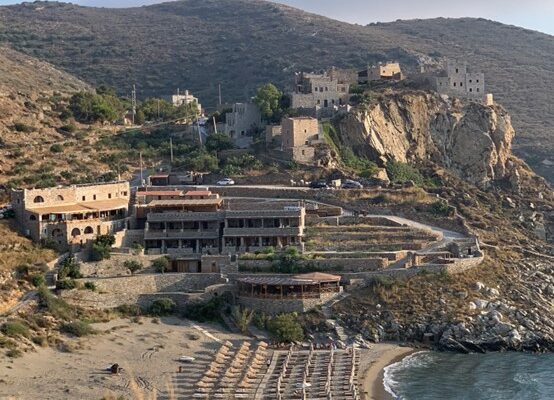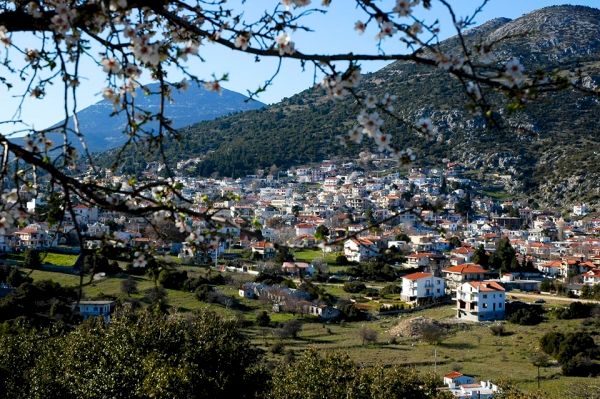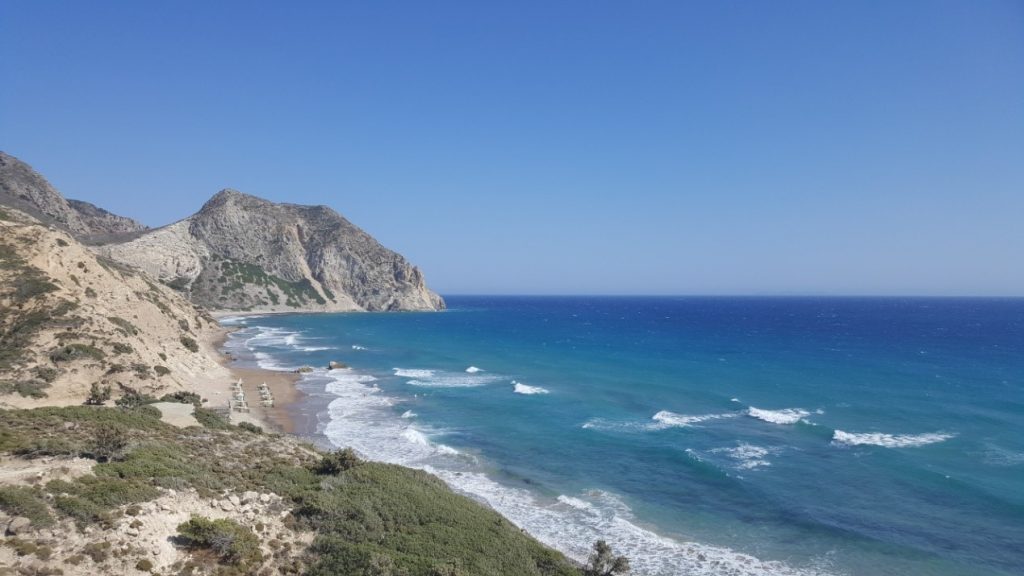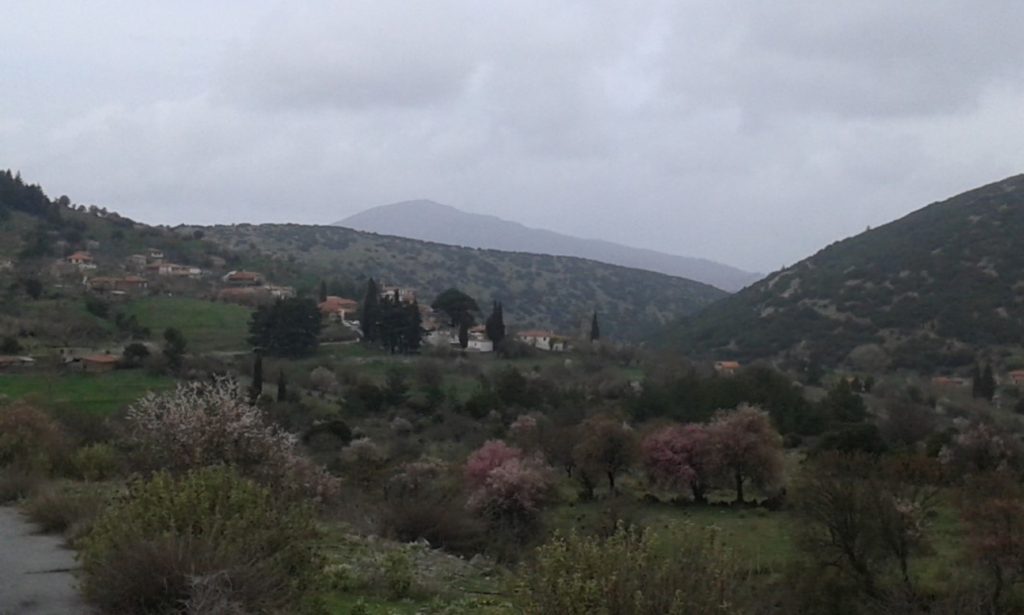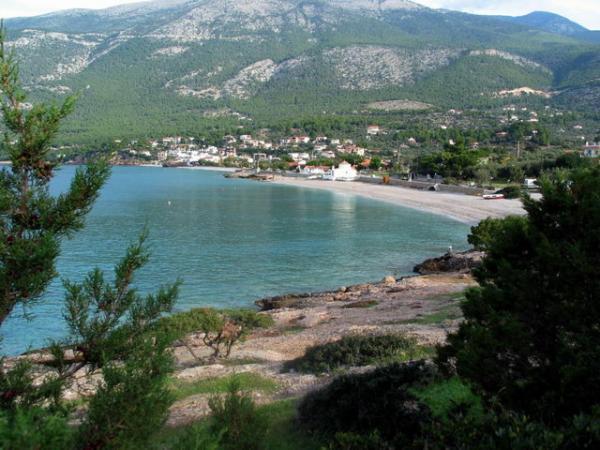New Archaeological Museum of Thebes
New Archaeological Museum of Thebes is one of the most important museums in Greece as it houses numerous findings from the history of Viotia. The new building has a showroom 1.000 sq.m. and consecrated in 07-06-2016. Developed on two levels, following the relief of the hill Kadmeia, on which is built. The Archaeological Museum of Thebes is a candidate for the prize "European Museum of the Year Award 2018», the institution European Museum of the Year Award (EMYA), which is under the auspices of the Council of Europe.
THEBES
Thebes is a city that belongs to the Municipality of Thiva, of Viotia prefecture bordering Attica. It is the birthplace of General Epaminondas, of Pelopida, history Hesiod and the lyric poet, Pindar. In the Greek mythology, here was born the god of joy, Dionysos, the son of Zeus and Queen of Thebes, SemeleAs well as the demigod Hercules, known by "12 feats».
Except Archaeological Museum Thebes Other major attractions of the area is Mycenaean Palace or "Kadmeio", the Sanctuary and Oracle of Ismene Apollo Ptoos, the "Amfeion ", the Ancient Theater Kaveiria and Sanctuary of Kaveires.
ANCIENT ACROPOLIS THIVAS - Mycenaean palaces or "Kadmeio"
«Val Ogigia Thebes» ie "antediluvian Thebes», rooted in prehistoric period that is why the first king of Thebes was called, Ogigia, meaning "the very old". In the Greek mythology, the first king Thebes, it was Cadmus, the son of the King of Phenicia, the Agenor.
The ancient citadel of Thebes named in honor of "Kadmeia " and was a fortress made of stone blocks, with cyclopean walls on a natural hill. The most significant monuments, it was the Mycenaean palace or "Kadmeio" (13th B.C.) which was at the citadel Kadmeia center, the Sanctuary of Apollo Ismini and "7 gates' leading to Kadmeia. The Sanctuary of Apollo Ismene was built on the ruins of an ancient temple, after the "Battle of Leuctra" (371 B.C.) The area has been excavated by A.. Keramopoullos (1910 – 1917) and N. Faraklou (1967).
Today only a few parts of the ancient wall, parts of clay roof tiles of Ismene and 2 from the 7 Gates of ancient Thebes.
SANCTUARY oracle Ismene APOLLO IN Ptoos
Is located 3 km east of the city Akraifnio, Mount Ptoon. Sanctuary and Oracle of Apollo originally built during the ancient times (7th B.C.) and refurbished in 4The B.C. after the reconstruction of Thebes by Cassander. In honor of Apollo became each 5 years, theatrical games, the "Ptoia».
Around the Sanctuary were votive Kouroi and tripods while inside the vessels have been found, utensils and many bronze statues dedicated to Apollo. All findings are in the Archaeological Museum of Thebes.
SANCTUARY Kaveiria – ANCIENT THEATER Kaveiria
The Theater is located 8 km, west of Thebes, next to the Sanctuary of Kaveires, which was devoted to chthonic deities. During the Hellenic times was used for sacrifice, as was the altar in the center of the orchestra.
"AMFEION"
The "Amfeion"Is a pyramid - tomb, height 33 m., the hill of Thebes. The "Amfeion" was the burial spot of two twin sisters, Zethos and Amphion, they named. The double grave, found after excavations of Th. Spyropoulos (1970), It was filled with lots of pottery and gold jewelry lying on the Archaeological Museum of Thebes.
ARCHAEOLOGICAL PLATEON
The Archaeological Area Plataea has segments of fortification of ancient Plataea (walls of the Mycenaean civilization and the Classical era,4th – 5th B.C.), ruins of the "Ireon», a small part of the guesthouse or "den» (426 B.C.) which served for the guests 'Heraion "and relics from'altar Eleftherios Zeus».
The "Ireon"I was in the NW. the fort and was a Doric temple dedicated to Hera where inside stood the statue of the goddess, work of Praxiteles.
THE "Altar of Zeus Eleftherios"Built by the Greeks, on demand of the Oracle of Delphi, to deliver value to Eleftherios Zeus, that gave them the victory at Plataea.
The "Battle of Plataea"Became the 479 B.C. at the foot of the mountain and covered the battle of the Greeks against the Persians. From excavations coins found, inscriptions, a tufa tripod boiler (8th) etc..
ANCIENT TANAGRA
The area inhabited by 4The B.C. and flourished by Mycenaean to Roman times. The ancient citadel of Tanagra was fortified with walls, towers and the sanctuary of Dionysus, the statue of the god sculpture by sculptor Praxiteles. many red-figure vases have been found with representations associated with Dionysus, Baby clay dolls'dolls» (4th), tombstones etc..
The excavations of Th. Spyropoulos (1969) the Mycenaean cemetery of ancient Tanagra have been found and are at the Archaeological Museum of Thebes the famous Mycenaean shrines, with impressive paintings. Also found thrones with painted decoration, figurines and vases, a double compass etc..
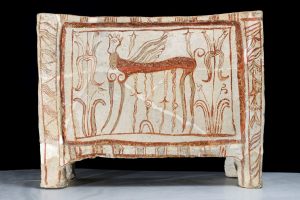
LARNACA WITH REPRESENTATION SFINGAS
Also at Thebes Museum you will see a female limestone statue of ancient Tanagra (650 – 600 B.C.), a black-figure skyphos a dance performance and many findings from excavations of I.. Threpsiadi (1956 – 1961), the Sanctuary of "Avlideias Artemis», City Aulis near Tanagra.
MYTHOLOGY RELATED TO THIVA
The word Thebes (plural) in mythology due to the city gates and the myth of Niobe so it Thebes called "seven-gate city». when Greek mythology The Wolf, king of Thebess and his wife, Dirki They persecuted and tortured their niece Antiope, because she had become pregnant outside marriage by Zeus. Subsequently, children who had managed to give birth Antiope in Jupiter, The Twins Amphion and Zethos They chased the Dirki and lupus and punished. indeed, according to the lost tragedy Euripides, «Antiope», the Dirki They killed the taping of the horns of a bull. The Twins Amphion and Zethos were heroes in Thebes.
THE Amphion married Niobe, daughter of King Phrygia, Tantalus. The Niobe gave birth to many children who were paired, that did 14 children, 7 boys and 7 girls, their niobids. When the Niobe He boasted that most children can do by Leto, with Zeus command, children of Leto, the gods Apollo and Artemis, killed children Niobe, their niobids and Amphion after that suicide.
According to legend, the ancient citadel of Thebes built by Amphion and Zethos and the mythical "7 Gates" of the walls of Thebes had names 7 niobids girls. Another Theban legend associated with Frixos and Elli, the children of the king of Orchomenos, Athamania and cloud and the chthonic deities Kaveires, who had the power to rattled and shoot fire on earth.
Theban Cycle
The Theban Cycle It is a collection of 4 lost epics associated with ancient Thebes, that they were written in 750 – 500 B.C. the 4 epics is "oedipal», the "Thebaid», the "progeny" and the "Alkmeonis». The Theban Cycle inspired the three Greek tragedians, Aeschylus, Sophocles and Euripides write their tragedies.
Aeschylus the trilogy that includes the works "Seven Against Thebes», «Laios" and "Oedipus», Sophocles with "Oedipus Tyrannus"Based in the House of Lavdakidon, committed crimes host of Thebes and Euripides with "Phoenician Women», also influenced by the House of Lavdakidon and the "The Bacchae», associated with Dionysus (Bacchus).
Aeschylus refers to Oedipus, his son Laius and Jocasta, where the tragic fate led him from Corinth, which grew from baby adoptee, at the King's court Polybos, Thebes. According to the oracle of Pythia, Thebes Oedipus killed his father Laius and married his mother Jocasta, ignoring its identity. Before he had killed the monster 'Sphinx», ensuring the Theban crown.
NEW Archaeological Museum of Thebes
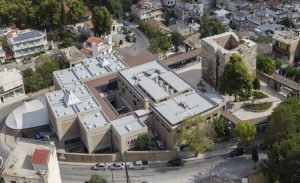
The Archaeological Museum, into 18 units, from which 11 It is chronologically, exposed the whole story of Viotia. Details after entering the museum you will find the following rooms:
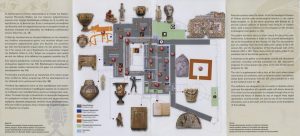
ANTECHAMBER
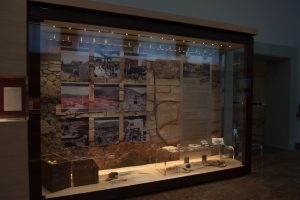
Room 2 "MYTH", It includes legends related to the history of Viotia and mainly Thebes and Orchomenus.
Room 3 "Stone Age", with man to make use of stone tools.
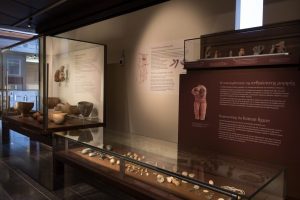
The time when man was first divided into three periods, the Stone (40.000 – 10.000 B.C.), the Mesolithic (10.000 – 6.500 B.C.) and the Neolithic (6.500 – 3.000 B.C.), depending on the tools found in excavations. In Greece the first appearance of man starts from the Mesolithic period.
Room 4 "Bronze Age", wherein the use and processing of metal begins.
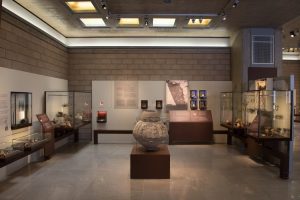
During this period Viotia inhabited by tribes of Achaean, of Minnie and of Kadmeia. The Minyes They settled in Orchomenos Boeotia led by Minyas managed to gain strength and power. Dry Lake Kopais and cultivating acquired great economic prosperity.
In this period they were built many palaces, mainly in Eutresis and Gla regions. In Glas excavations unearthed the Mycenaean citadel or castle Gla (1300 B.C.). It is the largest fortified Mycenaean citadel preserved in Greece, work of Minnie Orchomenos, near Castle Viotia.
Orchomenos has found the Mycenaean tomb Minyas (1250 B.C.), known as "Treasure Minyas», which they were buried in the royal family of Minyas. It is an overground, vaulted marble tomb which is considered one of the greatest monuments of Mycenaean architecture. It comes from Orchomenus and "Kouros Orchomenos» (550 -540 B.C.), from Paros marble now in the Archaeological Museum of Chaeronea. The Eutresis excavated between 1924 -1927 and studies have shown that the city was inhabited from the Neolithic era. In Eutresis found Sanctuary of Apollo Eftrisiti with many bronze and terracotta votive (6th -5th B.C.) located in the Archaeological Museum of Thebes.
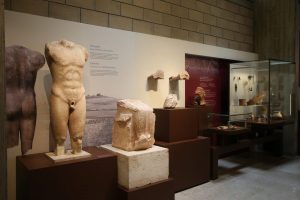
Room 5 "Mycenaean", findings from the Mycenaean palace of Thebes and Orchomenos.
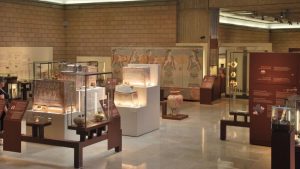
The excavations on Mount Ptoon unearthed the remains of at least 90 votive Kouroi, from the Temple of Apollo Ptoos. They are made of local limestone or marble of Paros or Naxos. The Kouros is Boeotian art but with island effect and characterized by a slight "smile", ie moderate.
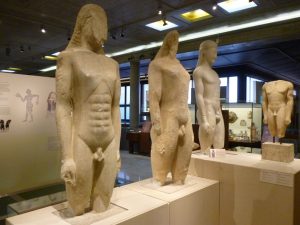
Most Kouros found in Thebes Museum besides a marble votive Kouros, height 1,30 m. located at the National Archaeological Museum of Athens.
Room 6 "GEOMETRIC", Geometric and Geometric times.
Viotia begins to gain strength, Trade, metalwork and ceramics. During this period the ceramic vascular enriched besides performances and geometric shapes.
Room 7 "Ancient", establishing the Boeotian Federation.
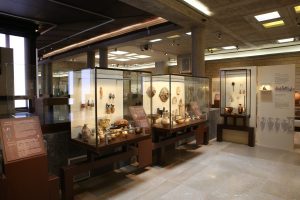
The era was marked by the establishment of "Joint Boeotian» (5th B.C.) a leading city of Thebes. many coins, figurines, clay and bronze objects from this period are in the Archaeological Museum of Thebes.
Room 8 "CLASSIC", It includes objects mainly from the Theban Hegemony (371 – 364 B.C.). At that time Thebes was a city - state led by Pelopidas (364 B.C.) and Epaminondas (362 B.C.). In this room stands a bronze statue, with the signing of Praxiteles, The tombstone of Filotera, from Thespiae (400 B.C.) and funerary "black bars" of Mnason and Rynchonos, from Thebes (5th B.C.).
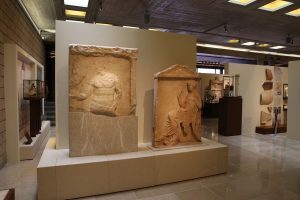
EPITYMVIES COLUMNS
Room 9 "Hellenists", the term refers to conflicts of Viotia, with exhibits like bronze clasps, helmets etc.. The region after many battles completely weakened, lost its former glory until he reached the Roman allegiance.
The most important battles of this period was "Battle of Plataea» (479 B.C.), the "Battle Koroneia» (394 B.C.), the "Battle of Leuctra» (371 B.C.) and especially "Battle of Chaeronea» (338 B.C.), between Macedonians and Athenians. Of the cities allied with Athens, the war against the Macedonians, Thebes was the "Representation of Viotia". the Macedonians, by King Philip II came out winners in the "Battle of Chaeronea", made near the ancient Chaeronea in Boeotia, thus prevail in the region Macedonian Hegemony. The hatred of the Thebans for the Macedonians was such that trying to liberate their city from the Macedonian garrison in their block Kadmeia. When learns that the M. Alexander arrives at Onchisto Viotia (335 B.C.) He sets up his army across from Thebes and with the help of the Macedonian garrison that manages and coming off the walls Kadmeia place the "Destruction of Thebes". The city was completely destroyed and the rebuilting 316 B.C., its successor M. Alexander, Cassander.
The Thebans in memory of the heroes who perished in the "Battle of Chaeronea", the burial of the dead point, They erected a marble lion on a pedestal, height 5,30 m., known as the "Lion of Chaeronea". Excavations here have brought to light skeletons 254 men and some of their equipment. The "Lion of Chaeronea" is located next to the Archaeological Museum of Chaeronea, in the distance 13 km from Livadia.
Room 10 "ROMAN", is the period from 197 B.C. where Thebes subjugated by the Romans and has been a great decline. The only region inhabited this season was Kadmeia. Here there are various bronze votive offerings from the Sanctuary of Apollo Ismini, such offerings in the form of animals, arms, pottery, etc..
Room 11-13 "BYZANTINE", wherein the edge of the Post Byzantine illustrated Viotias, Byzantine and Late Byzantine period. At this time in Thebes trade flourishes, silk production, production of agricultural products and tapitourgeia. Specifically during the Byzantine and post times (395 – 1204 A.D.) Thebes was the seat of General of the "Thread of Greece", i.e. military region Byzantine Empire N. Greece.
The late Byzantine period and Frankish (1204 – 1460 A.D.) marked by the Frankish "Duchy of Athens» (1205 – 1456 A.D.) which they were members of Athens and Boeotia. Founded in 1205 the Crusaders, after the conquest of Istanbul when Fourth Crusade (1204) and held until the occupation of Athens by Ottoman (1456).
Room 14 "OTTOMAN" (1460 – 1821 A.D.)
In this room there are various exhibits relating to the period of Ottoman rule in Viotia arriving until the establishment of the New Greek State.
In the balcony you will see :
Room 15-16 «Boeotian MYTHS & DRAMA», Myths from ancient to modern times with reference to the tragedies of the Theban Cycle.
In the covered area of the museum will see, visible foundation of the Museum, home department (3or millennium BC), several tombs (17th B.C. c.) and a part of the foundation of the Mycenaean Wall of Kadmeia (13th B.C.).
numbers 17-18. In the courtyard of the museum area you will see many stone monuments and the medieval Tower Saint Omer. The Tower Saint Omer is a remnant of the dynasty of the Franks who dominated at Thebes with their French house Nobles, Of The rock, Of Brienne and Saint Omer. built in 1278 from Saint Nicolas III – Omer (1258 – 1294) and served as the residence of.
ACCESS
Thebes is from Athens 93 km (about 1 time) and accessible from the National Road. Athens - Lamia.
If you have your own transport you can go to Thebes and the Old National Road. Athens - Thiva.
You can also go by bus N.. Viotia or by train OSE to Thebes Railway Station and then to the Archaeological Museum located, about 1 km.
useful information
Municipality of Thiva, tel. : 22623-50600-2, www.thiva.gr
Archaeological Museum of Thebes, Threpsiadou 1, Pl. Keramopoulou Thebes, tel. : (+030)22620-23559, (+30)22620-27913, www.mthv.gr
bus N.. Viotia, hearth 10, Thebes, tel. : 2262027511-2, www.ktelthivas.gr
Thebes Railway Station, OSE Thiva, tel. 1110 or 22620-27531, www.ose.gr
Radio Taxi "CADMUS", Thebes, tel. 22620-27077, 22620-80777

